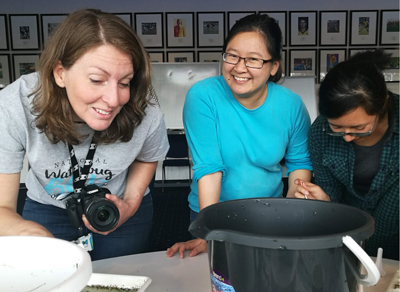City of Melb Waterbug Blitz

Results of water sampling show that our two sites and those from Royal Park have the highest number of waterbugs and habitat ratings. Westgate Park samples showed the most species or biodiversity.
| WESTGATE PARK | |||
| Date of monitoring | 20 Oct 2018 | ||
| Site name | Dam outlet | ||
| Specific name | Common name | SIGNAL SCORE | Raw count |
| Physa acuta | Marbled menace | 2 | 10 |
| Family Chironomidae, several genera | Blood worms | 4 | 3 |
| Family Culicidae | Mosquito larvae | 1 | 1 |
| Family Dytiscidae | Two-tailed tiger | 6 | 2 |
| Families Tabanidae, Dolichopodidae, Empididae some Tipulidae | Assorted River- ine maggots | 3 | 7 |
| Family Corixidae, Genus Sigara | Striped boatmen | 4 | 1 |
| Family Hydrophilidae | Water scavenger beetles | 2 | 2 |
| Phylum Turbellaria | Flatworms | 2 | 1 |
| Family Chironomidae | Chironomids | 4 | 1 |
| Diaprepocoris barycephala | Barry four-eyes | 5 | 1 |
| Family Hydrophilidae, Genus Helochares | – | 2 | 2 |
| Family Ceratopogonidae | Biting midges | 4 | 1 |
| Date of monitoring | 20 Oct 2018 | ||
| Site name | Freshwater Lake | ||
| Specific name | Common name | SIGNAL SCORE | Raw count |
| Family Leptoceridae, Genus Triplectides | Stick caddis | 3 | 2 |
| Family Lestidae and Family Coenagrionidae | Leaf-tailed damselfly nymph | 1 | 2 |
| Coleoptera | Tiger beetle larvae | 1 | |
| Family Corixidae, Genus Sigara | Striped boatmen | 4 | 1 |
| Phylum Annelida, Class Hirudinea | Leech | 1 | 1 |
| Physa acuta | Marbled menace | 2 | 1 |
Notes by Ying, our WaterWatch Coordinator:
In summary, we found approximately 16 different taxa groups across two sites at the dam outlet and the freshwater lake (closer to the saltwater lake). More taxa groups are found in dam outlet and have a higher average SIGNAL score compared to the freshwater lake.
This SIGNAL score is a bio-indicator index for macroinvertebrates that indicates whether the macroinvertebrates are sensitive to the pollution level in the site. Each macroinvertebrate has been assigned a SIGNAL score of 1-10 and we calculate the overall SIGNAL score to determine how healthy our site is (e.g waterways, wetland). A higher SIGNAL score indicates healthy and less polluted sites. Urban sites usually have a lower SIGNAL score as there are more stormwater runoff and other urban pollution. Hence, we were not surprised to see many bugs with high pollution tolerance level (e.g. bloodworms, mosquito larvae).
I did not calculate the overall SIGNAL score for our sites as the calculation is based on a waterway site and not a wetland. What we found so far is quite indicative of how healthy our sites are and the results are pretty good considering these samples are taken within 15 mins of each and they are only a tiny part of the site.
I definitely think that there are a lot more waterbugs out there that we have not surveyed!
